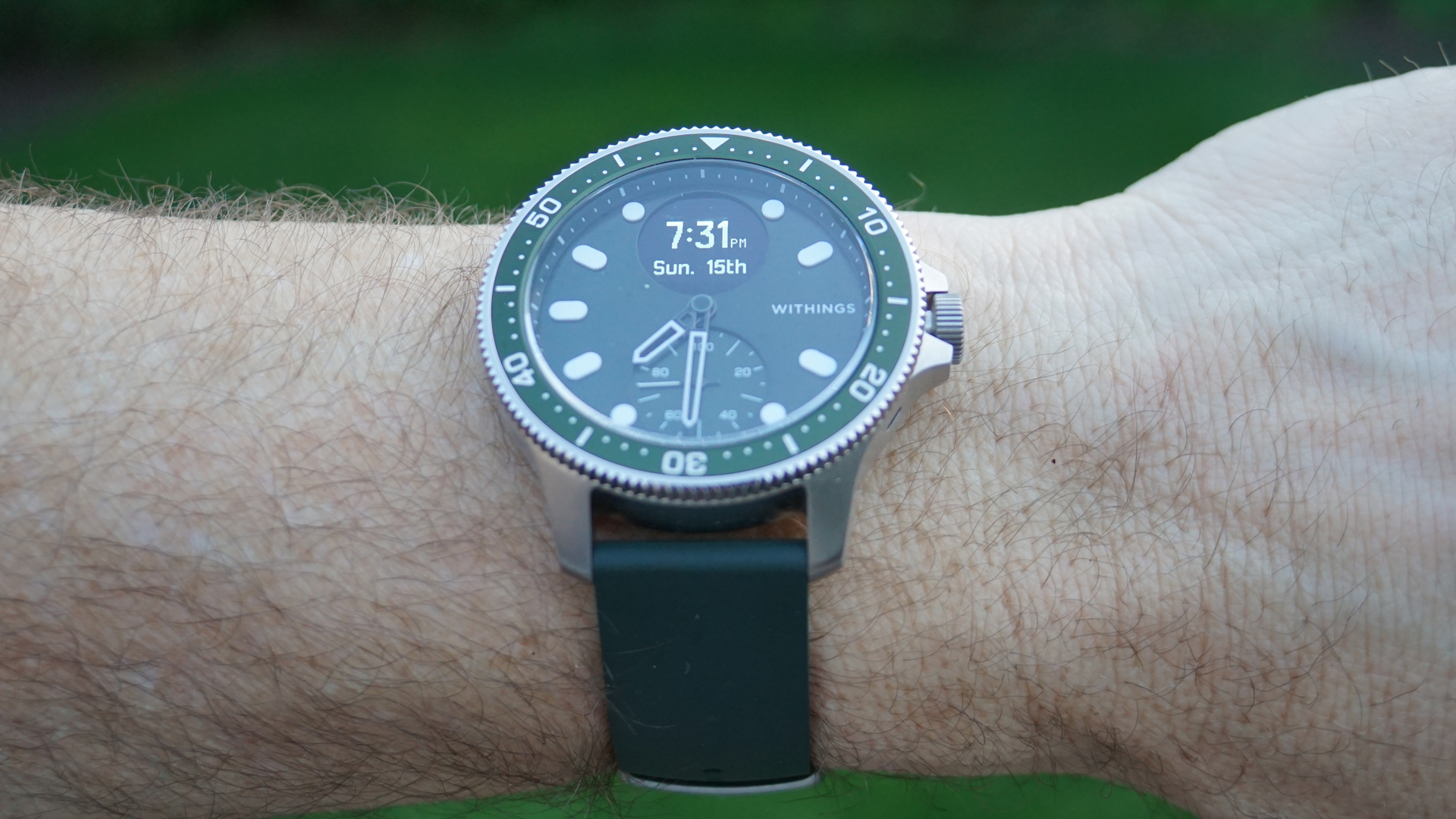TechRadar Verdict
While most of today's modern smartwatches are focused on fitness with health a close second, Withings ScanWatch Horizon flips the script, putting health alongside design with fitness a few steps behind. The beefy, classic looks just don't lend themselves to an aggressive workout, long run, or big swim. It can handle all that, but more delicate writsts might complain.
Pros
- +
It looks like a classic analog divers watch
- +
Doesn't skimp on intelligence
- +
Impressive heart, blood oxygen, breathing, and ECG monitors
- +
Unbeatable battery life
Cons
- -
Heavy
- -
Screen is so tiny
- -
Hard to find the perfect fit
- -
No voice assistant
- -
No GPS
Why you can trust TechRadar
Two-minute review
I have drawers full of analog watches that have sat unworn since I adopted the Apple Watch in 2015. Their classic dials, complications, ticking hands, and second hands are lost to progress.
Withings ScanWatch Horizon turns back the dial on that design progress, reacquainting me with a classic divers' watch design while holding onto the future in the form of a small, circular, monochrome digital window.
Withings likes to call the approach, which we first saw in a somewhat more lightweight form in the Withings ScanWatch, a "hybrid" analog watch.
At a glance, the ScanWatch Horizon looks like an expensive divers watch. It has the same thick, polished chrome body, crown, and rotating bezel originally designed to give divers a quick, glanceable warning that their oxygen might soon run out (ti serves almost no purpose on this device). On the watch face are analog, large, glow-in-the-dark hands and dial markings.
Flip the watch over, though, and it reveals itself as an intelligent wearable. There's an array of sensors on the base for passively reading heart rate and for active blood oxygen and ECG readings. There are other giveaways like the aforementioned screen at the top of the watch face and the crown. The latter is not used to set the watch. Instead, it's the lone navigation control for all the ScanWatch Horizon digital features.
A single press of the crown begins a tiny transformation. Press and the watch hands immediately rotate out of the way of the screen, hanging out at the "10" and "2" positions until you're done with the screen.
Withings married the watch with a rich Health Mate App to keep track of all the ways in which the watch is quietly collecting your vitals. It can, among other things, read your steps, elevation, heart rate, and sleep patterns.
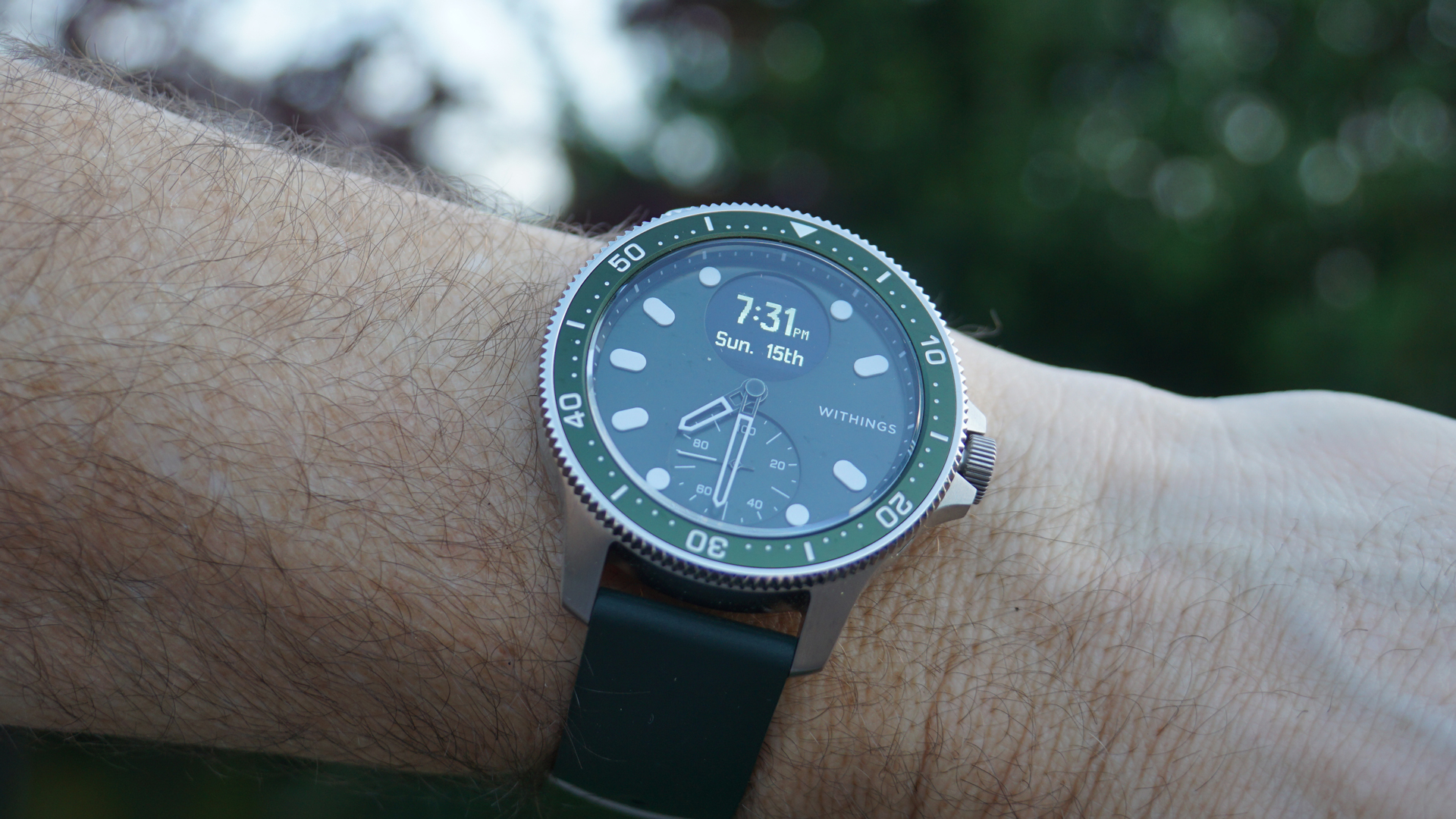
For all the years I've collected watches, I never wore one to bed and I only grudgingly did it with the Apple Watch when they introduced sleep tracking. It's not a natural thing for me. A light sleeper, I wake up noticing this thing on my wrist. That was with the comparatively svelte Apple Watch. The ScanWatch Horizon is a much bulkier and heavier device.
Somehow, though, I managed to sleep with it. What's impressive is how accurately it does read your sleep and breathing cycles, and equally impressive are the clinically backed ECG reading and SpO2 reports.
The app does an excellent job of collecting all and presenting it to you in a readable format. It can also be shared with Apple's Health app.
You can wear this watch constantly for, Withings claims, up to 30 days without a charge. I've been wearing it for more than a week on a single charge. It's nice not having to worry about getting the watch back to its charging base (though we do not love that charger).
This may be the perfect smartwatch for those who really don't want one. It has the look of a classic analog with the heart of an intelligent wearable. At $499, it's pricey, especially for a smartwatch with such a tiny, black and white screen. However, it's a bargain for a true diver's watch with clinical-level health tracking features.
Price and availability
The 43mm Withings Scanwatch Horizon is available for $499.95 (£ 499.95 ). That's roughly $200 more than Scanwatch's original, 38mm analog hybrid.
After being onsale in UK, France, and Germany since September, the watch is finally coming to the US on May 17, along with the rest of Europe also on May 17.
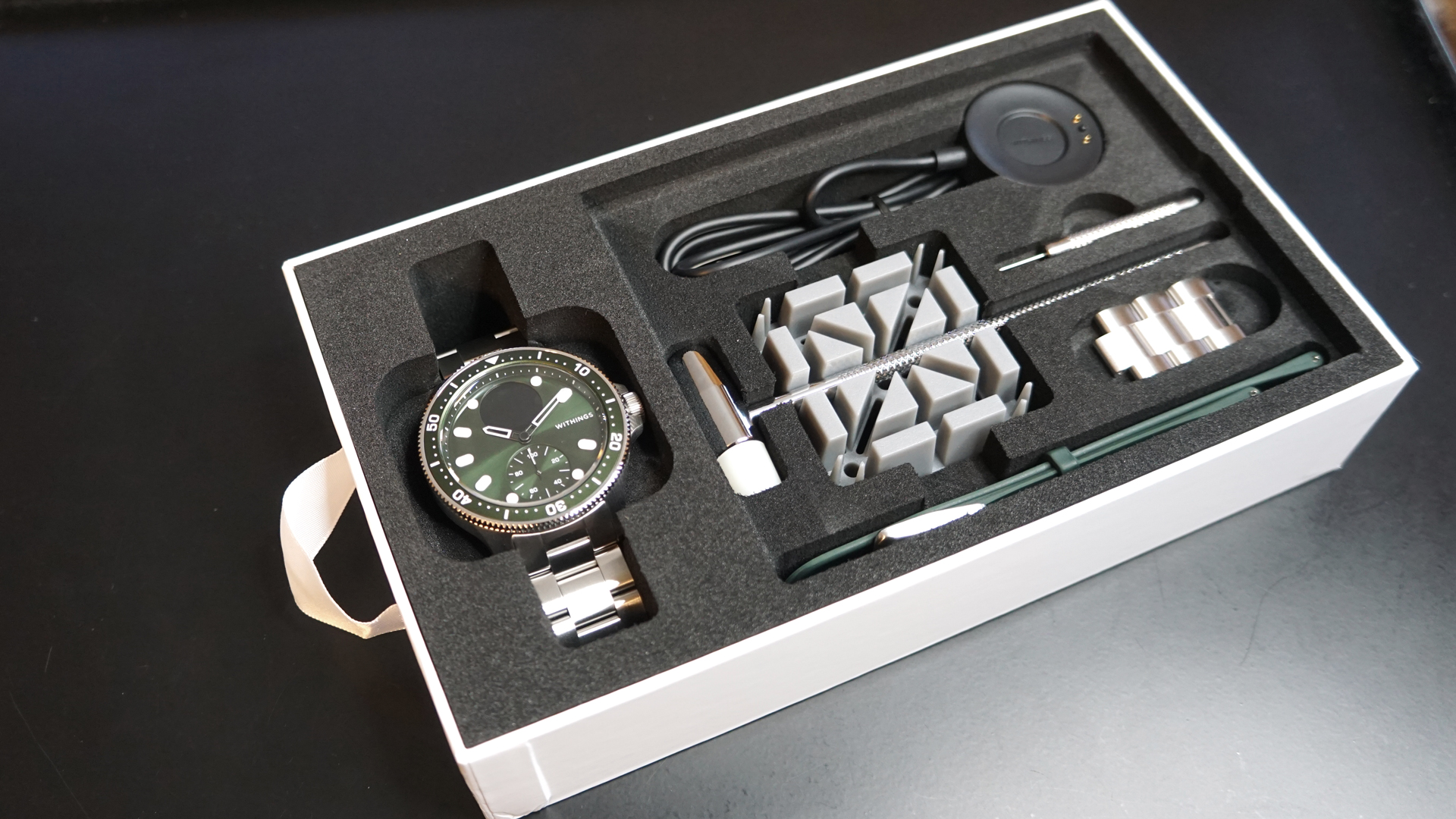
Design and display
- Bulky and bold
- Hybrid analog/digital design
- Controlled entirely via digital crown
Let's just say that everything else about the ScanWatch Horizon is bigger than the original SacnWatch, which came in 38mm and 42 mm varieties. The ScanWatch Horizon is a 43mm wearable and is 13.28-ins. thick (that's slightly over a half an inch).
While the ScanWatch weighed 58g (the smaller model and without the strap), the ScanWatch Horizon weighs in at 72g. It's a substantial device, even moreso if you wear it with the default metal band. The product ships with a band sizing kit that includes a pin pusher and a small hammer to drive that pusher into the pins holding the metal links together. There's even a plastic holder that keeps the watch and band in place while you work out the adjustment. It's an effective system, but no matter how I configured the segments, I couldn't find a combination that felt just right.
Also, since I knew I'd be sleeping with the watch on, I decided the flexible fluoroelastomer band would be lighter and a lot more comfortable (I was right).
The watch itself is beautiful. With its stainless-steel body, it really does look like a classic divers watch in the mold of, say, a Rolex. Under the clear, saphire glass is a green enamel face. That color scheme carries through to the thick rotatable bezel (which has no discernable purpose). There are the wide yet refined hour and minute hands (there's no second hand) and dial markings, all of which glow in the dark. There is also a smaller complicaiton activity dial that keeps track of your total progress toward your activity goal.
Sitting at 12 o'clock is the watch's sole digital display. It's a half-inch, monochrome LCD with enough resolution to offer a surprising amount of detail in that tiny space, but more on that later. Since the analog watch hands sometimes move over that screen, they will automatically shift out of the way (to 10 and 2) as soon as you press the digital crown.
The back looks nothing like an analog watch. There are three sets of sensors for heart rate, SpO2 levels, and electrodes for the electrocardiogram (there's also a hidden ECG sensor on the face of the watch).
The fit of the watch is important because the sensors need skin contact to work. As I noted, even with the fluoroelastomer band, I'm not sure I ever found the perfect fit. Fortunately, the watch never failed to deliver my health readings.
Switching bands, by the way, is quite easy. Both the metal band and the flexible one have quick-release pin bars (basically tiny handles attached to the spring-loaded pins that hold the bands in place). I simply pulled those back, slipped out the metal band, and then pulled the quick-release pins bars back on the fluoroelastomer band to slip it into place
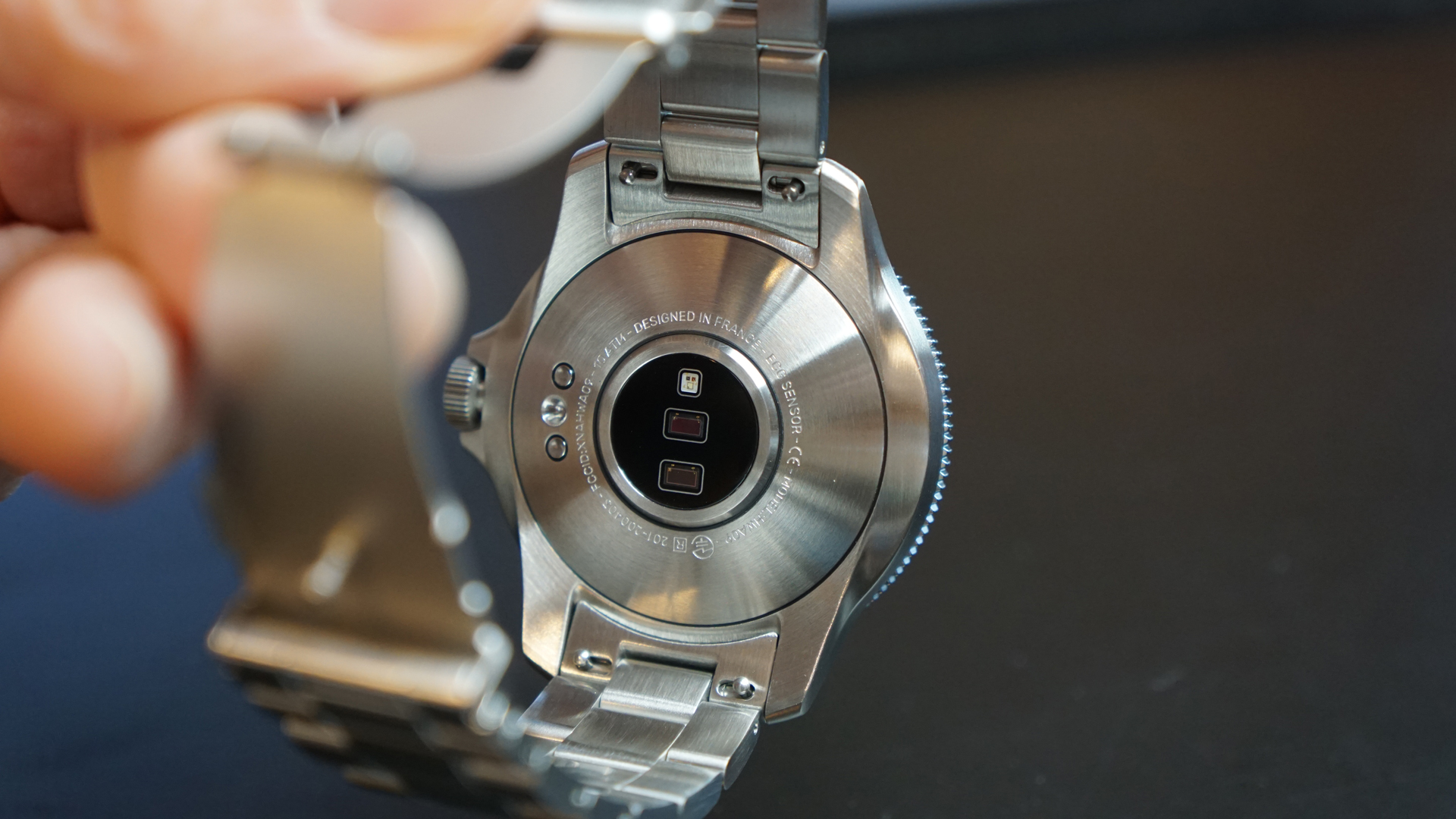
The crown and the tiny digital screen are really a complementary pair. You wake up the screen by pressing the crown and then scroll through on-display menus and features by spinning the crown. When you find a feature or activity you want to use, you press in the crown again.
In the case of workout options, I scrolled to the main workout menu, pressed the crown to see the workout options (Running, Swimming, Cycling, Walking, Other), pressed to select what I want, and then press the crown again to start, pause or stop the workout.
It can feel rudimentary compared to the full-color and rich menu system on the Apple Watch and, yes, those workout options are on the scant side, too. The ScanWatch Horizon isn't even capable of auto-detecting a workout as I can trust my Apple Watch to do.
Still, there is something to be said for simplicity, The lack of a ton of options and an a highly-designed and watch-face-eating display might be too much for some, especially those coming from the Fitbit world where they can buy a device like the Fitbit Inspire, which similarly keeps the display info to a minimum.
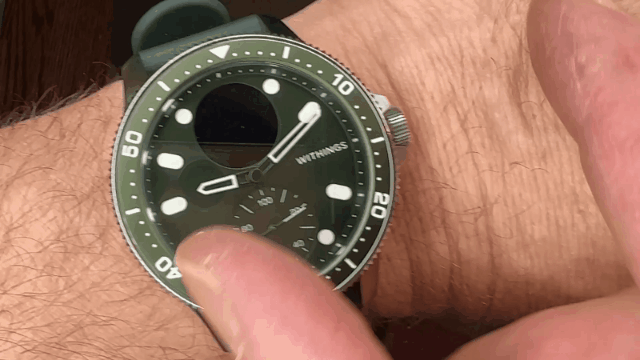
Getting started and keeping track
- Easy setup
- Accurately tracks activity
- Lots of health-tracking features
- Connects to phone and apps for notifications
Getting started with the Withing Scanwatch Horizon is easy. I started by fully charging the wearable on the included charging base. I'll admit, I'm not a fan of pin-based dock-charging systems. You must make sure to position the watch properly on the pins or it won't charge. It's not even held in place by strong magnets.
While the watch charged, I installed the Health Mate app, which is the same app used by all of Withing's health-related devices. It guided me through the Bluetooth pairing process and once the watch was fully charged (roughly 2 hours), it guided me through an extensive series of steps to enable all the active and passive health features.
You do have to authorize the sharing of information between Health Mate and the Apple Health App, giving the Health Mate the ability to update any metrics for which it collects data. It reminds you how to wear the watch and where to place it on the wrist for the best readings. There's guidance on the ECG and also a note that the device, which is FDA-cleared, cannot detect heart attacks and other medical conditions.
With all this done, the watch is ready to use and track your health and activity. I scrolled to the heart rate monitor and found I was beating at 68 beats per minute.
I ran an SPo2 test, which required me to sit still and place my hand over the face of the watch. When I felt a vibration, some 30 seconds later, the test was done. At 94% I was "below average." A subsequent reading put me at 96% - I think I'll be OK.
ECGs work almost exactly the same, except the first time I did it, the app let me know that Withings partner Heartbeat Health, had to review my personal information to "provide medical approval for you watch's ECG activitation." Fortunately, this only happens once.
In case you care, my sinus rhythm is normal.
Obviously, the ScanWatch Horizon doesn't just connect to my iPhone for health-and fitness related activities. Provided you give it permission, it can deliver all sorts of notifications that, yes, appear on that tiny, tiny screen. I read text messages (a single scrolling line), calendar alerts, got word of incoming calls. They were all accompanied by a noticeble device vibration.
It was all fairly low-key and I kind of liked it,
At night, I rolled into bed and even without changing a setting or touching the crown, the watch knew it and automatically tracked the lengthy of my sleep and its quality. Later I enabled the breathing monitoring and found that I was not having any significant breathing disruptions. I did wake up in the middle of most nights and became aware of the big watch on my wrist.
I honestly felt like this information in the Health Mate app was clearer and more useful than what I found in the Apple Watch's sleep tracking (yes, for a few nights I slept with both watches on - my wife thought I was insane).
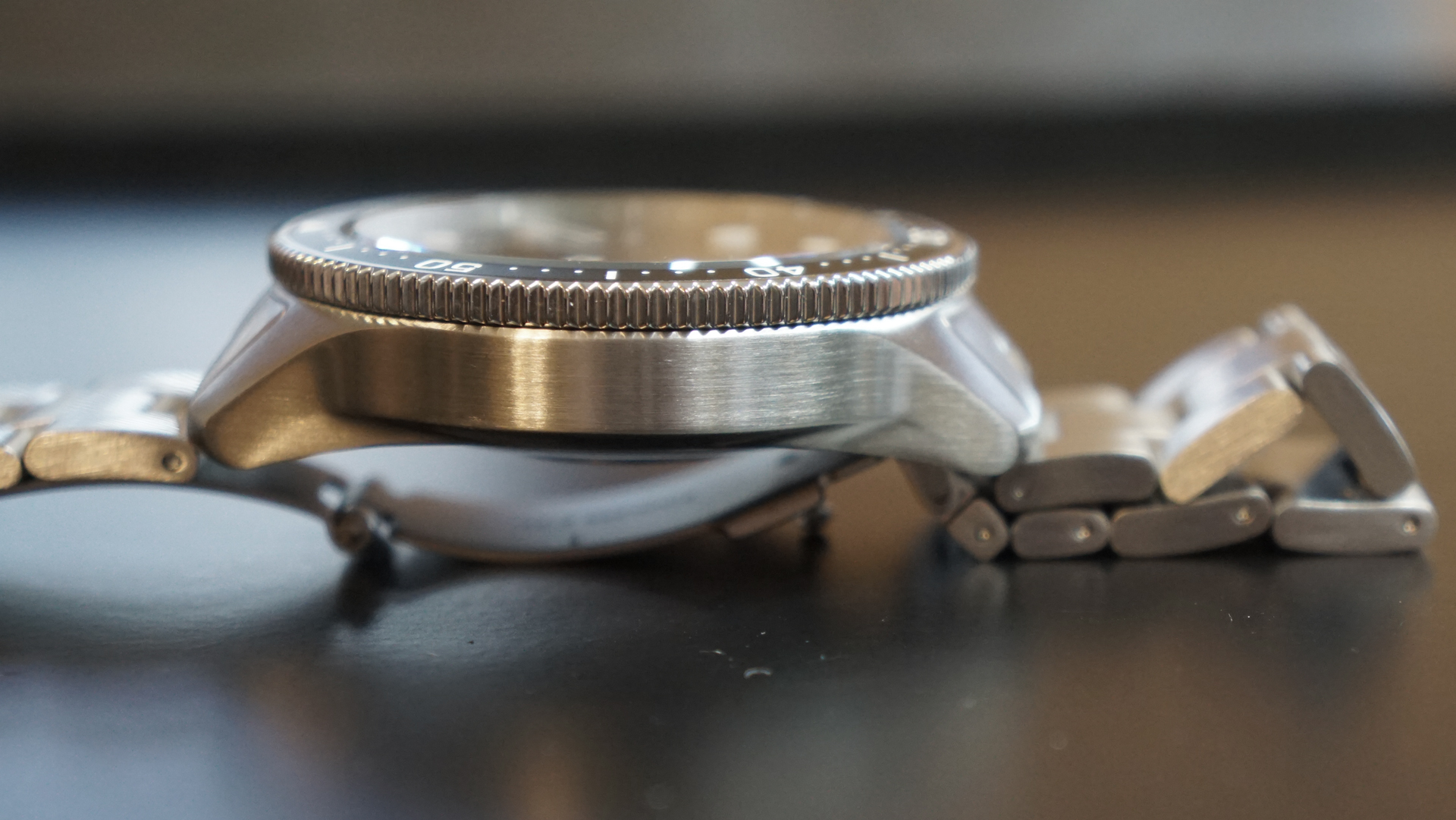
Fitness tracking
- Relatively few workout options
- No automatic fitness activity detection
- No on-board GPS
- Activity tracking works well
This is a decent fitness wearable, but, owing to its size and weight, it's not the least conspicuous. It's heavy and where the Apple watch is light and nothing but curves, this is a bulky watch with edges and a prominent crown.
I walked with it and did my weight work, crunches, curls, pushups, and pullups. All but the walking falls under the watch's "other" workout category.
There's no indoor and outdoor walk, just walk.
If you're a swimmer, this is a watch that's ready for you. Where the Scanwatch could handle depths of 5ATM (a measure of underwater atmospheric pressure), the ScanWatch Horizon is a "diver's" watch and can handle twice that depth (10ATM). I'm no diver, but I checked its virtually waterproof bonafides by dunking the watch in a sink full of water. It was fine. To be clear, 10ATM is definitely good for swimming and snorkeling, but might not be best for a deep dive.
Overall, the fitness features are useful if secondary to the health capabilities.
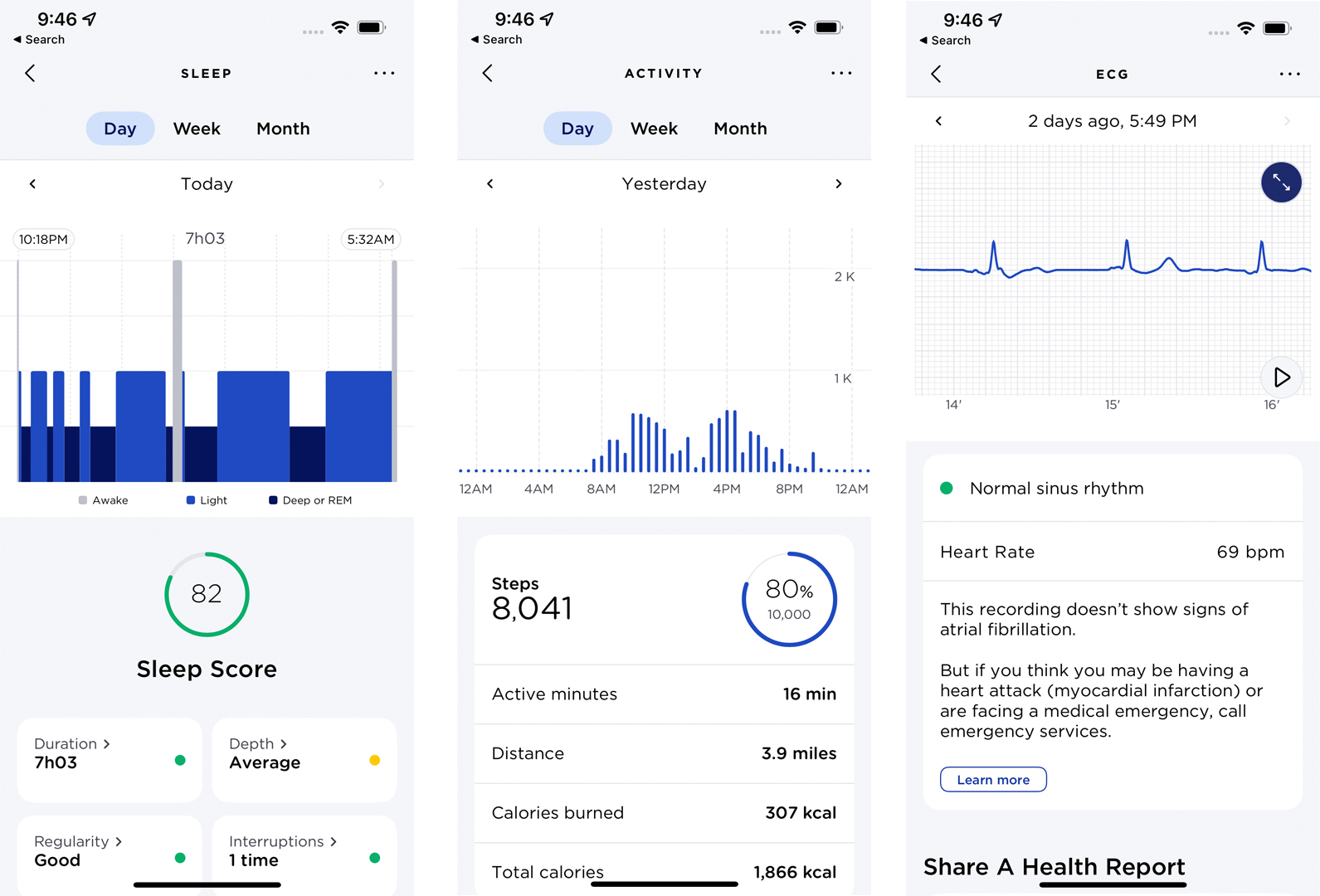
As I noted, the watch does handle cycling, running, and walking, but it won't know where you're going or where you've been without your phone's GPS - the watch has none of its own.
Seems like the $500 range should get you built-in GPS. There's certainly room in that case, but ScanWatch just didn't deem it necessary.
Battery life is, as you would expect, stellar. More than a week into testing and I have yet to recharge it. As I write this, I still have 39% battery life left. If I hadn't taken so many ECG and SPo2 tests, it might even last longer. My guess is, that with varied use, 15-20 days a charge is a reasonable expectation. Longer if you don't use the health-related tests very often.
That long battery life also helped the ScanWatch Horizon feel more like the traditional battery (even self-winding) watch your grandfather favored.
Overall, the Withings ScanWatch Horizon is an elegant addition to the smartwatch market. It takes the classic look and feel of a divers watch and blends in significant digital capabilities across the health, fitness, and notifications spectrums.
It's not as comprehensive as the Apple Watch, lacking microphones and connections to a voice assistant like Siri, but there's no way Withings intends that tiny digital screen to compete with Apple's high-resolution, full-color wearable display. The ScanWatch Horizon isn't as proactive, either, never realizing on its own when I've started a workout.
It's more than able to handle most any kind of workout, including an ocean dive, though the watch design isn't for someone who, say, when they're running, wants to forget they're wearing a watch.
This is the smartwatch for someone focused on health, the past, and unbeatable battery life.
Buy it if:
You miss the beefy and classic analog look and feel
The ScanWatch Horizon looks like a classic diver's watch and it doesn't skimp on materials. Marrying that to a true digital smart watch was a smart move and this will appeal to a certain watch customer.
You want to track your vitals
This watch has some powerful heart and health-tracking capabilities. I liked how they worked and the results they presented on the small screen and in the Health Mate app.
You demand digital simplicity
The benefit of the retro look and feel is that it boils all the confusing smartwatch information to one ultra-clear and quite a simple screen. The controls are basic but in a very good and useful way.
You only want to charge it 12 times a year
The ScanWatch Horizon has incredible battery life, lasting up to a month on a charge. Frequent use of the health detection features like SPo2 and ECG will cut down on it a bit.
Don't buy it if:
You have small wrists
This is a big, heavy smartwatch.
You don't want to spend a lot on classic looks
At almost $500, this is at the high-end of the fitness/health wearable spectrum. You're paying for the looks that you may not need.
- Take a look at our complete guide to the best fitness trackers

A 38-year industry veteran and award-winning journalist, Lance has covered technology since PCs were the size of suitcases and “on line” meant “waiting.” He’s a former Lifewire Editor-in-Chief, Mashable Editor-in-Chief, and, before that, Editor in Chief of PCMag.com and Senior Vice President of Content for Ziff Davis, Inc. He also wrote a popular, weekly tech column for Medium called The Upgrade.
Lance Ulanoff makes frequent appearances on national, international, and local news programs including Live with Kelly and Mark, the Today Show, Good Morning America, CNBC, CNN, and the BBC.
